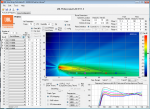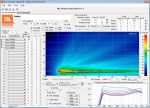At the risk of exposing my ignorance, I have a really stupid question about the end goal of a line array, particularly when physical constraints prevent "textbook behavior".
It’s well understood – even by me – that the frequency range that the array has pattern control relates to the length of the line; short lines lose pattern control at a higher frequency than a longer array. This is proportional to the length of the array, so doubling the length of the array gives another octave of pattern control. The problem is that no matter how long the array is, eventually you lose pattern control, and correspondingly lose the ability to equalize volume over distance for some portion of the frequency spectrum on the low end. So, what are you really trying to accomplish?
An example room that I work in a lot would be a hotel ballroom with about 14’ ceilings and maybe 80’ throw from the array hang to the back wall, with a flat floor.
After spending quite a bit of time in JBL LAC (which is really the only simulator I’ve tried that I actually believe the results from – the RCF, DBTech, and even Nexo sims seem to do some “massaging” of the numbers), there seem to be two possible approaches:
1. Optimize the sound pressure over distance for the frequency range the array can control and let all frequencies lower than that be what they are – 6dB falloff over distance meaning the array is more bass and low-mid heavy at the front of the room than at the back, but frequencies in the range where the array does have control are very similar over distance

2. Attempt to have the same frequency response at all places in the room, which means (for all of the room situations I’ve tried) you give up any attempt at equalizing the volume difference over distance. This seems, based on my noodling, to be best accomplished with a flat array slightly above ear height, which means you’re blowtorch loud at the front of the room.

The goal of even frequency response everywhere in the room is a noble one, as is the desire to have levels be as constant as possible. What gives first? Even with a 7’ long array, which seems to be “long enough” based on what I’ve read, and about as long as one can get away with in a room with a 14’ trim height, pattern control only extends down to about 250Hz. On paper, the identical frequency plots over distance for a flat array like in a ground stack configuration seem nice, but no one that I’ve ever heard of chooses a low ground stack when there’s a flying option available, and it’s not hard to think of the challenges of a wall of speakers 5’ off the ground.
Any clarity anyone can offer as to how this is done in “the real world” – meaning real rooms with normal gear, not Coachella with 30’ arrays for 150,000 people, would be appreciated.
Sorry again for the dumb question.
It’s well understood – even by me – that the frequency range that the array has pattern control relates to the length of the line; short lines lose pattern control at a higher frequency than a longer array. This is proportional to the length of the array, so doubling the length of the array gives another octave of pattern control. The problem is that no matter how long the array is, eventually you lose pattern control, and correspondingly lose the ability to equalize volume over distance for some portion of the frequency spectrum on the low end. So, what are you really trying to accomplish?
An example room that I work in a lot would be a hotel ballroom with about 14’ ceilings and maybe 80’ throw from the array hang to the back wall, with a flat floor.
After spending quite a bit of time in JBL LAC (which is really the only simulator I’ve tried that I actually believe the results from – the RCF, DBTech, and even Nexo sims seem to do some “massaging” of the numbers), there seem to be two possible approaches:
1. Optimize the sound pressure over distance for the frequency range the array can control and let all frequencies lower than that be what they are – 6dB falloff over distance meaning the array is more bass and low-mid heavy at the front of the room than at the back, but frequencies in the range where the array does have control are very similar over distance

2. Attempt to have the same frequency response at all places in the room, which means (for all of the room situations I’ve tried) you give up any attempt at equalizing the volume difference over distance. This seems, based on my noodling, to be best accomplished with a flat array slightly above ear height, which means you’re blowtorch loud at the front of the room.

The goal of even frequency response everywhere in the room is a noble one, as is the desire to have levels be as constant as possible. What gives first? Even with a 7’ long array, which seems to be “long enough” based on what I’ve read, and about as long as one can get away with in a room with a 14’ trim height, pattern control only extends down to about 250Hz. On paper, the identical frequency plots over distance for a flat array like in a ground stack configuration seem nice, but no one that I’ve ever heard of chooses a low ground stack when there’s a flying option available, and it’s not hard to think of the challenges of a wall of speakers 5’ off the ground.
Any clarity anyone can offer as to how this is done in “the real world” – meaning real rooms with normal gear, not Coachella with 30’ arrays for 150,000 people, would be appreciated.
Sorry again for the dumb question.
